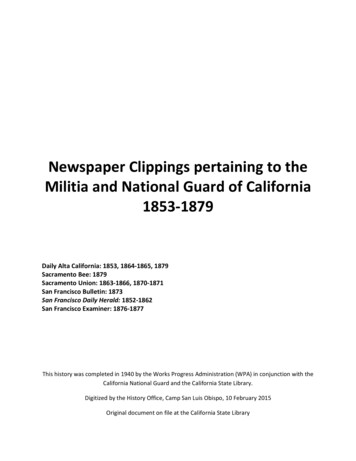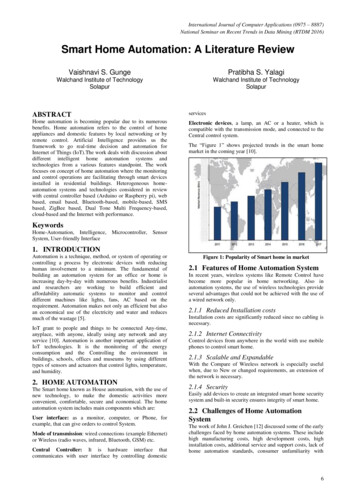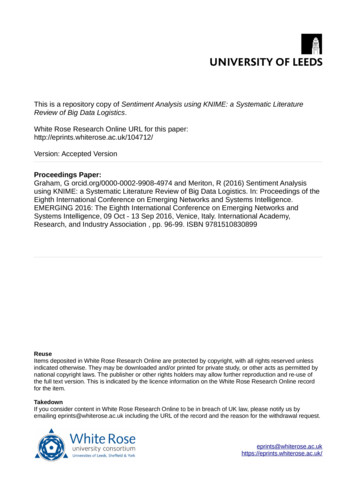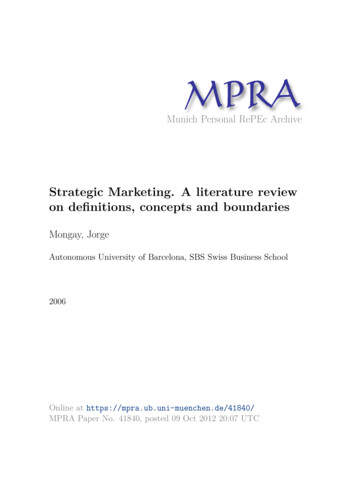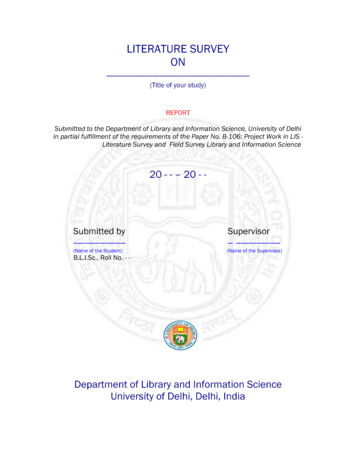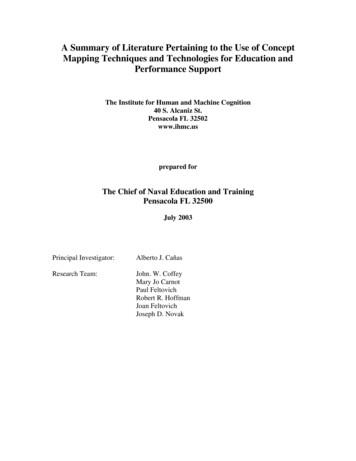
Transcription
A Summary of Literature Pertaining to the Use of ConceptMapping Techniques and Technologies for Education andPerformance SupportThe Institute for Human and Machine Cognition40 S. Alcaniz St.Pensacola FL 32502www.ihmc.usprepared forThe Chief of Naval Education and TrainingPensacola FL 32500July 2003Principal Investigator:Alberto J. CañasResearch Team:John. W. CoffeyMary Jo CarnotPaul FeltovichRobert R. HoffmanJoan FeltovichJoseph D. Novak
Table of ContentsList of Figures1. Executive Summary1.1. Background and Theory Pertaining to Concept Maps1.2. Educational, Business, and Governmental Uses of Concept Mapping1.3. Limits on Our Ability to Report1.4. Major Conclusions of this Report2. Construction Methods and Styles for Concept Maps2.1 Distinguishing Characteristics of Concept Maps2.2 An Example Concept Map2.3 A Basic Concept Map Construction Method2.4. Variations on the Basic Method2.5 Collaboration in the Construction of Concept Maps.2.6 Facilitation in Map Construction: Human Facilitators and Computer Support3. Applications in Educational Settings3.1 Uses of Concept Maps as a Tool for Support of Learning3.1.1 Identifying current understanding, misconceptions, conceptualchange3.1.2 Collaboration and Cooperative Learning3.2 Assessment of Learning Using Concept Maps3.2.1 The Utility of Using Concept Maps for Assessment3.2.2. Methods of Scoring Concept Maps3.2.3 Reliability and Validity of Concept Maps for Assessment3.3 Uses of Concept Maps to Organize and Present Information3.3.1 Concept Maps as “Advance Organizers”3.3.2 Concept Maps for Course or Curriculum Development3.3.3 Use of Concept Maps for Navigation Support3.4 Evidence of Effectiveness of Concept Mapping for Education3.4.1 Studies with Random Assignment of Learners to Conditions3.4.2 Studies in which Classes were Randomly Assigned to Conditions3.4.3 Studies that Utilized Extant Methods of Instruction3.4.4 Studies in which an Alternative Educational Intervention wascompared to Concept Mapping3.4.5 Studies that compared Concept Maps with other Forms of Learning Material2
4. Applications in Business and Government Settings4.1 Concept-Mapping as a Technique for Eliciting Knowledge4.1.1 Using Concept Mapping to Reveal Expert-Novice Differences.4.1.2 Using Concept Mapping With Domain Experts to Support the Designof New Technologies4.1.3 Evaluation of Concept Mapping as a Method for KnowledgeElicitation (KE) With Experts4.1.4 Using Concept Mapping as a Method in Software-AssistedKnowledge Acquisition (SAKA)4.2 Concept Mapping for Knowledge Management4.2.1 Brainstorming4.2.2 Knowledge Sharing4.2.3 Training and Performance Support4.2.4 Institutional Memory Preservation4.3 Other Examples from Industry4.4 Other Applications in Military Settings5. Software Support Tools5.1 Introduction: Tool Types and Purposes5.1.1 General Diagramming Tools5.1.2 Visualization Tools5.1.3 Knowledge/Memory Management Tools5.2 Concept Mapping Tools5.2.1 Commercial Tools5.2.2 Research Tool5.3 A Semantic Networking Tool5.4 Mind Mapping Tools5.5 Decision Making Tools/Group Organizers6. Summary and Conclusions7. References8. AppendicesAppendix A - Other Mapping SystemsAppendix B - Reliability and Validity of Concept Maps for Assessment3
List of FiguresFigure 1. A Concept Map that describes Concept Maps.Figure 2. A Concept Map pertaining to Mars Exploration Strategies.Figure 3. A Concept Map in progress on Solar Radiation from Navy studentAerographers.Figure 4. The final Concept Map on Solar Radiation from the Navy studentAerographers.Figure 5. Top Level Map for Managerial Decision MakingFigure 6. A Detailed Map pertaining to Statistical ModelsFigure 7. Top Level Curriculum Map developed by Edmondson and colleagues.Figure 8. Example of Graphical Browser Screen from Carnot et al. 2001.Figure 9. A Concept Map pertaining to People, Responsibilities and Activities in a Ear,Nose, and Throat Practice.Figure 10. The Interface to El-Tech, a Performance Support System for ElectronicTechnicians.Figure 11. A Depiction of a Global Process Knowledge Map.Figure 12. A Knowledge Map from TCU.Figure 13. An Example of Fisher's style of Semantic NetworkFigure 14. A Cognitive Map made with Decision ExplorerFigure 15. A Mind Map4
1. Executive SummaryConcept Maps are diagrams that represent organized knowledge (Novak &Gowin, 1984). This report is a summary and integration of published literature on theuses of Concept Maps to support human learning and workplace performance. It containsa summary of studies pertaining to the effectiveness of Concept Mapping for thesepurposes, and a description of commercial products that support Concept Mapping andrelated activities. The main goal of this report is to identify and highlight areas ofapplication of Concept Mapping for learning (training, knowledge sharing, etc.) andperformance support (decision-aiding, knowledge preservation, etc.).1.1. Background and Theory Pertaining to Concept MapsConcept Maps are graphical representations of knowledge that are comprised ofconcepts and the relationships between them. We define a concept as a perceivedregularity in events or objects, or a record of events or objects, designated by a label.Concepts are usually enclosed in circles or boxes, and relationships between concepts areindicated by connecting lines that link them together. Words on the linking line specifythe relationship between the concepts. The label for most concepts is a single word,although sometimes we use symbols such as or %. Concept-link-concept triples formpropositions, which are meaningful statements about some object or event. Sometimesthese are called semantic units, or units of meaning. Figure 1 presents a Concept Mappertaining to Concept Maps.Another characteristic of Concept Maps is that the concepts are represented in ahierarchical fashion with the most inclusive, most general concepts at the top of the mapand the more specific, less general concepts arranged below. The hierarchical structurefor a particular domain of knowledge also depends on the context in which thatknowledge is being applied or considered. Therefore, it is best to construct Concept Mapswith reference to some particular question we seek to answer, which we have called afocus question. The Concept Map may pertain to some situation or event that we aretrying to understand through the organization of relevant knowledge, thus providing thecontext for the Concept Map.Also important and characteristic of Concept Maps is the inclusion of “crosslinks.” These make explicit relationships between or among concepts in different regionsor domains within the Concept Map. Cross-links show how a concept in one domain ofknowledge represented on the map is related to a concept in another domain shown onthe map. In the creation of new knowledge, cross-links often represent creative leaps onthe part of the knowledge producer. An example in Figure 1 is the proposition “PerceivedRegularities or Patterns begin with Infants” which is cross-linked to the proposition“Creativity begins with Infants.”A final aspect of the structure of Concept Maps is the inclusion of specificexamples of events or objects. These can help to clarify the meaning of a given concept.Normally these are not included in ovals or boxes, since they are specific events orobjects and do not represent concepts.5
Figure 1. A Concept Map that describes Concept Maps.Concept Maps were developed in the course of Novak’s research program inwhich he sought to follow and understand changes in children’s knowledge of science.Novak’s work was based on the learning psychology of David Ausubel (1968, 1978). Thefundamental idea in Ausubel’s cognitive psychology is that learning takes place by theassimilation of new concepts and propositions into existing concept and propositionalframeworks held by the learner. This knowledge structure as held by a learner is alsoreferred to as the individual’s cognitive structure.One of the most fundamental goals in the use of Concept Maps is to fostermeaningful learning. Ausubel made the very important distinction between rote learningand meaningful learning, and stated that meaningful learning requires three conditions:1. The material to be learned must be conceptually clear and presented withlanguage and examples relatable to the learner’s prior knowledge. Concept Mapscan be helpful to meet this condition, both by identifying general concepts priorto instruction in more specific concepts, and by assisting in the sequencing oflearning tasks though progressively more explicit knowledge that can beanchored into developing conceptual frameworks.2. The learner must possess relevant prior knowledge. This condition can be metafter age 3 for virtually any domain of subject matter, but it is necessary to becareful and explicit in building concept frameworks if one hopes to presentdetailed specific knowledge in any field in subsequent lessons. We see, therefore,that conditions (1) and (2) are interrelated and both are important.6
3. The learner must choose to learn meaningfully. The one condition over whichthe teacher or mentor has only indirect control is the motivation of students tochoose to learn by attempting to incorporate new meanings into their priorknowledge, rather than simply memorizing concept definitions or propositionalstatements or computational procedures. The creation of Concept Maps supportsthe incorporation of new meanings into prior knowledge.Another very powerful use of Concept Maps is as an evaluation tool, thusencouraging students to use meaningful-mode learning patterns (Novak & Gowin, 1984;Novak, 1998; Mintzes, Wandersee & Novak, 2000). Concept Maps are also effective inidentifying both valid and invalid ideas held by students. This use will be discussedfurther in another section. They can be as effective as more time-consuming clinicalinterviews for identifying the relevant knowledge a learner possesses before or afterinstruction (Edwards & Fraser, 1983).There is an important relationship between the psychology of learning, as weunderstand it today, and the growing consensus among philosophers and epistemologiststhat new knowledge creation is a constructive process involving both our knowledge andour emotions or the drive to create new meanings and new ways to represent thesemeanings. Learners struggling to create good Concept Maps are themselves engaged in acreative process, and this can be challenging to many, especially to learners who havespent most of their life learning by rote. Rote learning contributes very little at best to ourknowledge structures, and therefore cannot underlie creative thinking or novel problemsolving. Concept Mapping is an excellent exercise for the promotion of creative thinkingand identification of new problem-solving methods.1.2. Educational, Business, and Governmental Uses of Concept MappingConcept Mapping has been put to many uses in education, business andgovernment. One of the original uses in education was for the assessment of what alearner knows. Concept Maps can be used to externalize and make explicit the conceptualknowledge (both correct and erroneous) that students hold in a knowledge domain. Theprocess of Concept Mapping for educational purposes can foster the learning of wellintegrated structural knowledge as opposed to the memorization of fragmentary,unintegrated facts.In educational settings, Concept Maps can also be used to organize instructionalmaterials for individual courses or entire curricula. Concept Maps have been used toserve as navigational aids for hypermedia, as a scaffold for understanding, forconsolidation of educational experiences, to improve affective conditions for learning, asan aid or alternative to traditional writing, and to teach critical thinking.Concept Maps and Concept Mapping also have utility in corporate andgovernmental organizations. To the degree that these entities carry out education andtraining of their personnel, educational applications are pertinent here as well.Furthermore, Concept Mapping can be used for knowledge capture – for the elicitation ofexpert knowledge that an organization might wish to preserve and share with others. In7
addition, Concept Mapping can be used in support of group processes such asbrainstorming. A Concept Map’s concise, visual representation of knowledge “at aglance” can simplify the conveyance of understandings, and fosters discussion. ConceptMaps can serve as a tool for reaching consensus through the creation and refinement of aConcept Map upon which members of a group can agree.1.3. Limits on Our Ability to ReportA great deal of literature pertains to the use of Concept Mapping for educationalpurposes in educational settings. It is natural that this area would contain a large body ofliterature since it is in educational settings that Concept Mapping originated. The shearvolume of this literature makes it infeasible to perform a truly comprehensive review inwhich each and every report is summarized in detail.The opposite problem seems to exist in the uses of Concept Mapping tools andsimilar knowledge representations to enhance workplace performance. The use of suchtools in competitive corporate settings is often viewed as an element of competitiveadvantage that companies are somewhat reluctant to share. For this reason, publicliterature pertaining to specific uses of Concept Mapping and similar strategies inbusiness settings tends to be much less voluminous and somewhat more superficial andanecdotal than literature from educational settings.1.4. Major Conclusions of this ReportConcept Maps differ from other types of mapping systems, such as KnowledgeMaps, Conceptual Graphs, and Mind Maps because of: their grounding in Ausubel’sAssimilation theory of learning, their semantic and syntactical (structural) organization,the nature of concepts that comprise the nodes in a Concept Map, and the unconstrainednature of linking phrases. A standard procedure for Concept Map construction invo
that new knowledge creation is a constructive process involving both our knowledge and our emotions or the drive to create new meanings and new ways to represent these meanings. Learners struggling to create good Concept Maps are themselves engaged in a creative process, and this can be challenging to many, especially to learners who have spent most of their life learning by rote. Rote .
